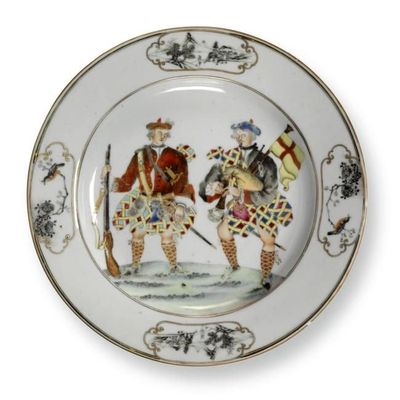

PERIOD: 18th century
CHINESE EXPORT 'SCOTSMAN' PLATE CIRCA 1745-50 painted with two members of the Highland Regiment in full regalia, one supporting a rifle, the other playing a bagpipe affixed with the regimental flag, and the rim with four gilt-edged panels of Chinese riverscapes alternating with a bird perched on a flowering peony branch. Small chips. PROVENANCE Charles H. Perry, Atlanta, Georgia, February 24, 1984 EXHIBITED London, A Tale of Three Cities, 1997, no. 135 LITERATURE AND REFERENCES David S. Howard, A Tale of Three Cities: Canton, Shanghai & Hong Kong, p. 112, no. 135 CATALOGUE NOTE An identical plate is illustrated by Howard and Ayers, Vol. I, p. 239, no. 234, who provide an interesting account of the decoration: "The piper is copied faithfully from the 1743 frontispiece [drawn and] engraved by George Bickham for A short history of the Highland Regiment..." (The regiment represented here is "the 42nd Foot, amalgamated later with the 73rd and became the Black Watch....) The private is also after a Bickham drawing of the same date. The piper has been reversed, but the rifleman is as he appears in the drawing....These prints had also been sold separately...in 1743 as a 'set' of four by John Bowles, and it seems probable that that two [of the prints] were taken to China (rather than a copy of [the book])." The occasion commemorated on John Bowles' 'set' of prints occurred on July 18, 1743, when "Riflemen Farquar and Shaw, together with Samuel and Malcolm McPherson of the 42nd, were shot at the Tower, while Piper Macdonnel [or Macdonald] was among those sent as a convict to Georgia [in America] for their part in a mutiny....As Macdonnel was a piper, it was inevitable that the very recent print of a piper of the 42nd should be used and given his name. It is thought that Piper Macdonnel's companion on the porcelain is Rifleman Shaw, but it may equally well have been another of these 'Jacobite martyrs'." In fact, Le Corbeiller, 1974, p. 95, no. 38, identifies the piper (fig. 51) as "Alexander Monro, 'piper to ye prince'," (Charles Edward Stuart: 'Bonnie Prince Charlie'), and she notes that an undated version of the print of the private (fig. 52) "is inscribed, in an apparently contemporary hand, 'The Scottish Highlander "Hamilton" who was executed on Tower Hill at the time of the Rebellion 1745'." With respect to the date of the Scotsmen plates, Howard and Ayers, ibid., comment that it is probable "that the order was sent to China in or before 1745, for thereafter the [Jacobite] cause lay in ruins and the memory of the mutiny of the 42nd Regiment and its martyrs was quite obliterated." The same account is provided by David Howard, "Chinese Porcelain of the Jacobites," Country Life, January 24, 1973, pp. 243 and 244, and a similar plate is illustrated as pl. 2. Similarly decorated plates of which, according to Howard and Ayers, ibid., p. 239, "at least twenty are known," are illustrated by Beurdeley, p. 99, color pl. XIX; by Hervouët and Bruneau, p. 225, no. 9.90; by Hyde, p. 89, pl. XV, fig. 52; by Le Corbeiller 1974, p. 95, no. 38; by Lunsingh Scheurleer, pl. 205; and by Veiga, p. 288, pl. 264. A bowl with this 'Scotsman' decoration, sold at Christie's in London on April 6, 1998, lot 151, is illustrated by Fuchs, p. 132, no. 83, who also illustrates on p. 133 a detail of the piper and the George Bickham print, circa 1742. The aforementioned plate illustrated by Howard and Ayers, ibid., p. 239, was in the collection of Mr. and Mrs. Rafi Y. Mottahedeh, sold in these rooms on October 19, 2000, lot 196, and is now in the Peabody Essex Museum, Salem, Massachusetts.
PRIX: $35000